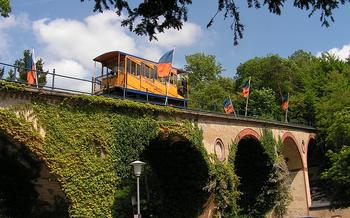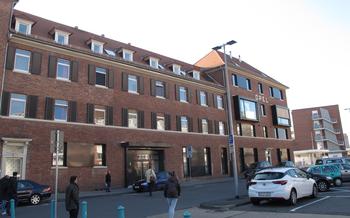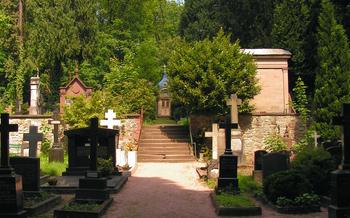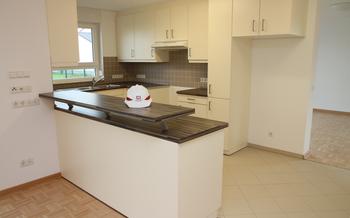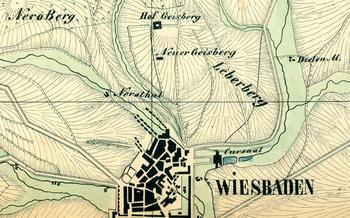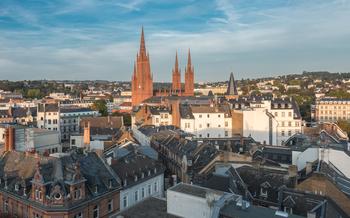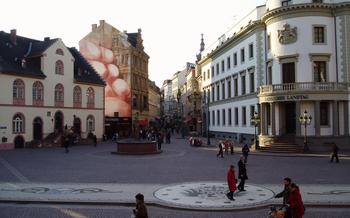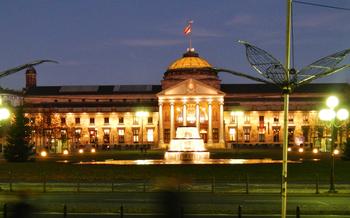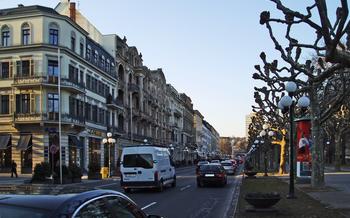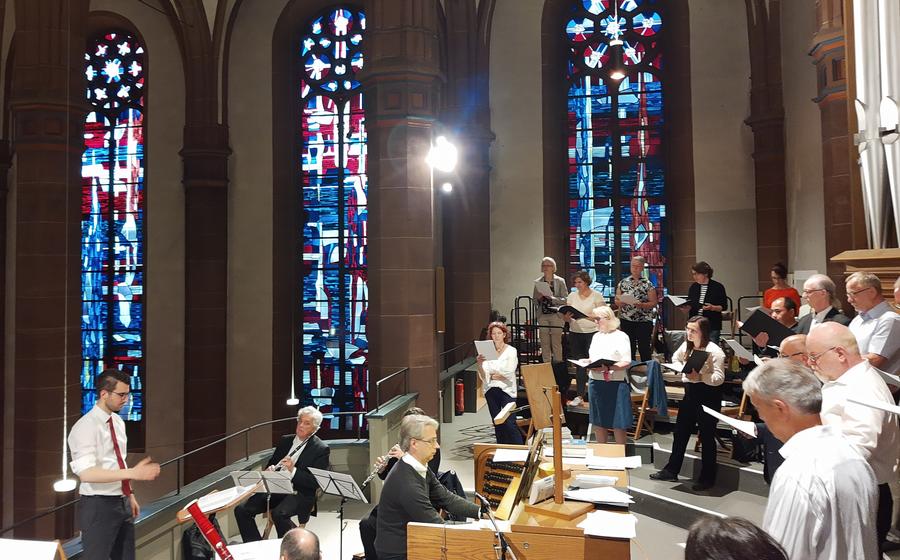
St. Bonifatius
- A City of History and Elegance in the Heart of Germany
- St. Bonifatius Church: A Masterpiece of Neo-Gothic Architecture
- Exploring the Church's Interior: A Journey Through Time
- The Legacy of St. Boniface: A Saint's Impact on Wiesbaden
- Unveiling the Crypt: A Hidden Gem Beneath the Church
- A Place of Worship and Community: St. Bonifatius Today
- Tips for Visiting St. Bonifatius Church
- Transportation and Accessibility: Getting to St. Bonifatius
- Nearby Attractions: Exploring Wiesbaden's Treasures
- Insider's Tip: Discovering the Secret Garden
- Capture the Moment: Photography Opportunities at St. Bonifatius
- Beyond St. Bonifatius: Exploring Wiesbaden's Diverse Faiths
- Insider Tip: Join the Parish for a Deeper Experience
A City of History and Elegance in the Heart of Germany
Wiesbaden, a captivating city nestled in the heart of Germany, boasts a rich tapestry of history, architectural marvels, and natural wonders. Its allure is further enhanced by its thermal springs, renowned for their therapeutic properties, and a vibrant cultural scene that enchants visitors throughout the year.
Immerse yourself in the city's storied past as you explore its enchanting streets, lined with elegant buildings that whisper tales of bygone eras. Admire the grandeur of the Stadtschloss, the former residence of the Dukes of Nassau, and marvel at the neo-Gothic splendor of the Marktkirche, a testament to the city's architectural prowess.
Wiesbaden's reputation as a spa town dates back to Roman times, and its thermal springs remain a source of rejuvenation and relaxation. Indulge in a soothing soak in one of the city's many thermal baths, allowing the warm, mineral-rich waters to ease away stress and revitalize your body and soul.
The city's cultural calendar is brimming with events that cater to every taste. From classical concerts and art exhibitions to lively festivals and theater performances, Wiesbaden offers an array of experiences that ignite the senses and leave lasting memories.
St. Bonifatius Church: A Masterpiece of Neo-Gothic Architecture
In the heart of Wiesbaden, nestled amidst a tapestry of historical landmarks, stands the magnificent St. Bonifatius Church, a testament to the city's rich architectural heritage and deep-rooted faith. Constructed between 1849 and 1853, this Neo-Gothic masterpiece boasts an impressive array of design elements that blend seamlessly to create a breathtaking sanctuary.
The church's exterior is a symphony of intricate details, with soaring spires reaching towards the heavens, buttresses providing structural support and visual interest, and ornate tracery adorning the windows, casting intricate shadows upon the surrounding grounds. The facade features a stunning rose window, a hallmark of Gothic architecture, which captivates the eye with its vibrant stained-glass depictions of biblical scenes.
Stepping inside St. Bonifatius Church is a journey through time, where the grandeur of the past intertwines with the spiritual essence of the present. The nave, with its soaring height and elegant proportions, creates a sense of awe and reverence. The ribbed vaults, supported by slender columns, converge gracefully towards the apse, drawing the gaze towards the sacred altar.
Exploring the Church's Interior: A Journey Through Time
Stepping inside St. Bonifatius Church is like stepping back in time. The awe-inspiring interior is a testament to the skill and artistry of the 19th-century craftsmen who created it. The church's stained-glass windows are a particular highlight, casting a kaleidoscope of colors onto the marble floors below. Each window depicts a different scene from the life of St. Boniface, telling the story of his missionary work and martyrdom.
The intricate ceiling frescoes are another masterpiece, illustrating biblical scenes and stories of saints. The vibrant colors and lifelike figures seem to come alive, adding a sense of drama and wonder to the church's interior. The elaborate altarpieces are equally impressive, featuring intricate carvings, sculptures, and paintings that depict scenes from the life of Christ and the Virgin Mary.
The attention to detail in St. Bonifatius Church is simply breathtaking. From the ornate carvings on the pews to the delicate tracery of the stained-glass windows, every element contributes to the church's unique character. It is a place where visitors can truly appreciate the beauty and craftsmanship of a bygone era.
The Legacy of St. Boniface: A Saint's Impact on Wiesbaden
St. Boniface, born in England in 675 AD, played a pivotal role in spreading Christianity throughout Germany. His tireless efforts as a missionary brought him to Wiesbaden in 744 AD, where he left an indelible mark on the city. St. Boniface's dedication to his faith and his contributions to the community earned him the title of patron saint of Wiesbaden.
The church bearing his name stands as a testament to his enduring legacy. It serves as a place of pilgrimage for those seeking spiritual guidance and inspiration. St. Boniface's life and work continue to resonate with the people of Wiesbaden, who hold him in high regard. His unwavering commitment to spreading the Gospel laid the foundation for the strong Christian community that exists in Wiesbaden today.
Beyond his religious influence, St. Boniface also had a profound impact on the cultural and social fabric of Wiesbaden. His teachings promoted unity, compassion, and understanding among the people. He encouraged education and knowledge, leaving a lasting legacy that continues to shape the city's cultural identity.
Unveiling the Crypt: A Hidden Gem Beneath the Church
Beneath the magnificence of St. Bonifatius Church lies a hidden gem—the crypt. Constructed in the 19th century, this subterranean chamber is a testament to the church's rich history and enduring legacy. Its vaulted ceilings and intricate stonework create a solemn atmosphere, inviting visitors to delve into the depths of the church's past.
Within the crypt, one can find the remains of St. Boniface, the patron saint of Wiesbaden. Enshrined in a beautifully crafted sarcophagus, his presence fills the space with a sense of reverence and awe. Visitors are drawn to the crypt to pay homage to this revered figure and to experience the palpable connection to the church's origins.
The crypt is not merely a repository of the past but also a place of active remembrance. Regular services and commemorative events are held here, fostering a profound connection between the living and the departed. The crypt's atmosphere of tranquility and devotion serves as a reminder of the enduring power of faith and the eternal legacy of those who have shaped the church's history.
A Place of Worship and Community: St. Bonifatius Today
St. Bonifatius Church remains a vibrant place of worship and community, drawing believers from across Wiesbaden and beyond. The active parish community organizes regular services and events, fostering a sense of unity and belonging among its members. The church serves as a focal point for religious celebrations, baptisms, weddings, and funerals, marking important milestones in the lives of its parishioners.
Beyond its spiritual significance, St. Bonifatius Church plays a vital role in promoting interfaith dialogue and understanding. It actively engages with other religious communities in Wiesbaden, participating in joint initiatives and events that foster tolerance and cooperation. The church's commitment to interfaith dialogue reflects its belief in the power of unity and the importance of respecting diverse religious traditions.
Tips for Visiting St. Bonifatius Church
To ensure a smooth and enjoyable visit to St. Bonifatius Church, consider the following tips:
-
Opening Hours: The church is generally open to visitors daily, but hours may vary. Check the official website or contact the parish office for specific opening times.
-
Guided Tours: Guided tours of the church are available upon request and offer a deeper insight into its history, architecture, and significance. Advanced booking is recommended, especially for groups.
-
Dress Code: While there is no strict dress code, visitors are encouraged to dress respectfully, covering their shoulders and knees. Modest attire is appropriate for a place of worship.
-
Photography Guidelines: Photography is permitted inside the church for personal use. However, using flash or tripods is typically discouraged to avoid disturbing other visitors or damaging the artwork.
Transportation and Accessibility: Getting to St. Bonifatius
Reaching St. Bonifatius Church is a breeze, thanks to Wiesbaden's efficient transportation network. Public transportation enthusiasts can hop on a bus or tram and alight at the "Bonifatiuskirche" stop, just a stone's throw from the church's entrance. For those who prefer the convenience of their own vehicle, ample parking is available in the vicinity, ensuring a hassle-free visit. Visitors with disabilities can rest assured that the church is fully accessible, with designated ramps and elevators providing effortless access to all areas.
Nearby Attractions: Exploring Wiesbaden's Treasures
St. Bonifatius Church is just one of the many gems that Wiesbaden has to offer. Embrace the opportunity to explore this vibrant city and discover its other captivating attractions.
-
Kurhaus Wiesbaden: This majestic building is a symbol of Wiesbaden's elegance. Marvel at its grand architecture, stroll through its beautiful gardens, and enjoy a performance at its renowned concert hall.
-
Nerobergbahn: Experience breathtaking panoramic views as you ascend the Neroberg hill aboard the Nerobergbahn, Germany's oldest funicular railway. Immerse yourself in the natural beauty of the surrounding countryside.
-
Wiesbaden Thermal Baths: Wiesbaden is renowned for its thermal springs. Indulge in a rejuvenating spa experience at one of the city's many thermal baths, including the luxurious Kaiser-Friedrich-Therme.
-
Schloss Biebrich: Explore the grandeur of Schloss Biebrich, a beautiful baroque palace located on the banks of the Rhine River. Admire its opulent interiors, wander through its extensive gardens, and learn about its fascinating history.
Insider's Tip: Discovering the Secret Garden
Beyond the grandeur of St. Bonifatius Church lies a hidden gem—a secluded garden that offers a tranquil oasis amid the urban bustle. Nestled between the church's walls and a neighboring building, this secret garden invites visitors to escape the city's noise and immerse themselves in a world of serenity.
Follow the discreet path that leads from the church's side entrance, and you'll find yourself surrounded by lush greenery, fragrant flowers, and the gentle sound of birdsong. Hidden paths meander through the garden, revealing tranquil spots perfect for reflection and relaxation.
Take a moment to sit on a secluded bench beneath the shade of a towering tree, letting the peace of the garden wash over you. Admire the vibrant colors of the flowers, the delicate petals of the roses, and the intricate patterns of the leaves.
The secret garden is a place where time seems to slow down, allowing you to appreciate the simple beauty of nature. Whether you're seeking a moment of solitude or a peaceful retreat with friends, this hidden gem is a must-visit for anyone exploring St. Bonifatius Church and Wiesbaden's many treasures.
Capture the Moment: Photography Opportunities at St. Bonifatius
The grandeur of St. Bonifatius Church provides ample opportunities for capturing stunning photographs. With its intricate details and imposing architecture, the church offers a feast for the eyes.
To capture the church's majestic exterior, position yourself at a distance to encompass its full height and width. Experiment with different angles to highlight specific features, such as the spires or the intricate carvings on the façade.
When photographing the interior, focus on the interplay of light and shadow. The stained-glass windows cast a warm glow, creating a dramatic effect, especially during the golden hours of sunrise and sunset. Use a tripod to ensure sharp images and capture the intricate details of the frescoes and carvings.
Don't forget to explore the hidden corners of the church, such as the crypt and the side chapels. These areas often reveal unique perspectives and details that might go unnoticed at first glance.
Remember to be respectful when taking photographs, especially during religious services. Silence your camera and avoid using flash to minimize disruptions. By following these tips, you can capture the essence of St. Bonifatius Church and preserve its beauty for years to come.
Beyond St. Bonifatius: Exploring Wiesbaden's Diverse Faiths
Wiesbaden is a city that embraces diversity, and this extends to its religious landscape. While St. Bonifatius Church is a prominent symbol of the city's Christian heritage, there are other churches and religious sites worth exploring that represent different faiths and cultures.
One notable example is the Russian Orthodox Church of St. Elizabeth, a beautiful building with golden domes that stands as a testament to the city's Russian Orthodox community. The mosque in Wiesbaden is a vibrant center for the Muslim community, offering a place of worship and cultural exchange.
In the spirit of interfaith dialogue, Wiesbaden actively promotes understanding and tolerance among different religions. The city hosts regular events and initiatives that bring together people from various faiths to share experiences, foster dialogue, and break down barriers.
Through these initiatives, Wiesbaden showcases its commitment to creating an inclusive and harmonious society where people of different beliefs can live together in peace and mutual respect.
Insider Tip: Join the Parish for a Deeper Experience
For a truly immersive experience, consider joining the parish community of St. Bonifatius Church. Participate in regular services, such as Sunday Mass or special holiday celebrations, to witness the vibrant faith and traditions of the congregation. Take part in community events, like charity drives or social gatherings, to connect with the parishioners and gain insights into their lives. Joining the parish offers a unique opportunity to not only admire the church's architectural beauty but also to become a part of its living, breathing community.
